| |
|
|
|
CIVIL WAR MODEL 1859 McCLELLAN SADDLE GIRTHS
SEVERAL NICE SPECIMENS TO COMPLETE YOUR SADDLE:
An absolute necessity in order that the saddle remain on
the horse, and the trooper retain his seat, the girth
was one of the most critical pieces of equipment issued
to the mounted soldier, and yet apparently very few
girths that were issued with the McClellan Saddles
during the Civil War and into the first years of western
Indian Wars remained with the saddles as they passed
into the post-service surplus market. As a result, many
of these historic saddles that exist today in
collections are missing the girths.
While the standard pattern Model 1859 Girth, as
described in the Ordnance Department regulations, was
manufactured with an indigo blue woolen webbing body,
variations such as all leather girths or linen and
leather girths, adhering in every way to the
standard pattern save for the material of the body, are
well known. Though associated commonly with officers
saddles, examples of these variant girths have been
found on the Civil War and early Indian War Enlisted
McClellan Saddles and they consistently lack the
individual flavor associated with an officers private
purchase saddle girth.
I currently have the following girths in stock and each
one is described and priced individually below with
accompanying photographs.
|
|
NO. 1
MODEL 1859 McCLELLAN SADDLE GIRTH
LINEN VARIANT:
A very interesting variant
recently found in a large long established eastern
collection, this Model 1859 McClellan Saddle Girth
adheres to the regulation pattern in every way, save for
the body of the girth being made of cream colored heavy
linen cloth.
Certainly either originally made by a civilian
contractor during the Civil War with this linen body or
later configured by an army saddler using the original
safes and hardware, there is no doubt this girth was
produced during the period of use of the
Civil War and early Indian Wars McClellan Saddles.
This is evidenced by the presence of a legible US
Government Inspector's stamp on the leather safe under
the "D" ring. The weave of the linen is very
similar to that found in the material used to fashion
the blue and yellow Model 1872 Girths, and as different
color striping patterns are known to have been used on
those girths, it is possible this girth is one of a few
trial girths made up at the arsenals. The
stitching and assembly of this girth is very well done -
typical of the quality of work done at the arsenals and
far better than the work products of the unit level
saddlers.
It is interesting to note that there is a wrapping of
thread used to assemble the girth around one end of the
linen webbing. It is not stitched down and was
obviously added to provide the soldier with a sufficient
length to perform a repair in the field should it be
necessary.
Like so many anomalies in horse equipment and
accoutrements which are found from the Civil War - Early
Indian War era, there is no known documentation to
support their existence or explain the reasoning behind
the modifications, but nonetheless there is no doubt
that the army was dedicated to improving the equipment
issued to the soldiers and to that end, produced many
pieces such as this girth which have yet to be fully
understood.
Measuring 20 Ύ long and 4" wide, this girth is in
excellent condition with all the components intact.
There are two separate straps of the linen webbing - a
wide section forming the main body of the girth and a
second narrower section overlaid on the wider section,
probably done to strengthen the finished girth.
Both leather safes are full form with no weak points,
the leather is still very strong and pliable, and the roller buckle
and "D" ring are fully functional.
This
is an excellent piece of Civil War
or Early Indian War Cavalry horse equipment, and one
that was only recently discovered in an old collection.
A unique and interesting variant, this girth would certainly complement
your Civil War or early Indian War Cavalry saddle
collection. (0407) $650
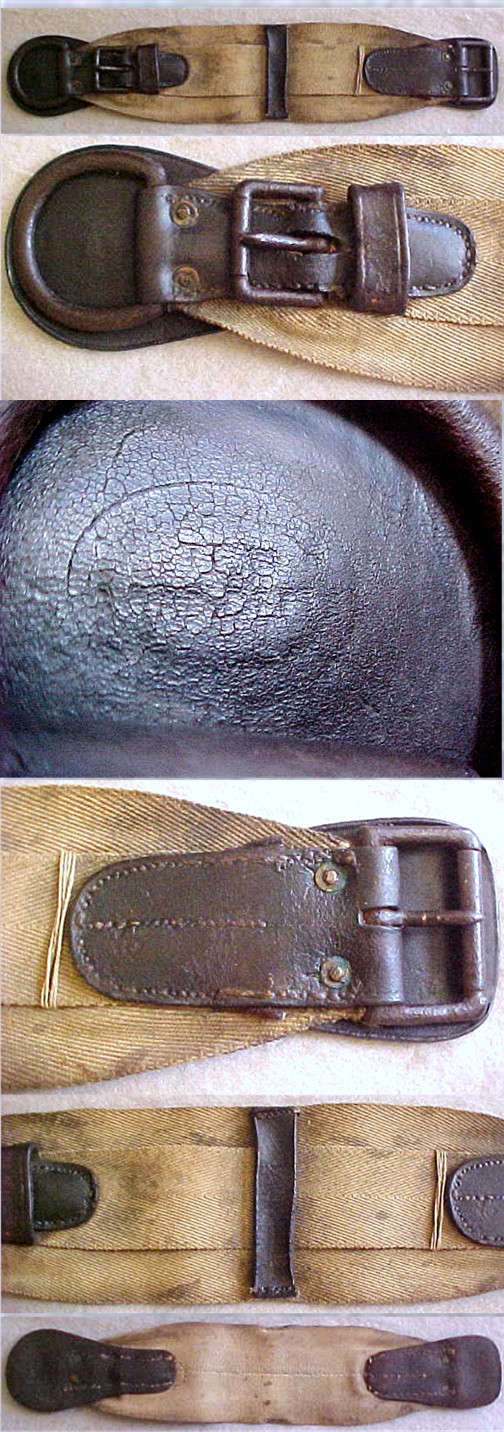
|
|
NO. 2
MODEL 1859 McCLELLAN SADDLE GIRTH
LEATHER VARIANT:
Recovered from a relic
Civil War McClellan Saddle, there is little doubt this
girth was original to the period of use of the saddle
either during the Civil War or during the early years of
the western Indian Wars.
While there is no known surviving record which explains the
existence of these all leather girths on the standard issue saddles, it
reasons that as the woolen bodies of the standard
issue girths wore out, the leather billets, still in
serviceable condition, were removed and used by the unit
saddlers to make a replacement girth using a leather
body. These leather girths are not particularly common,
but would be a correct addition for either a standard
pattern Civil War McClellan, any of the officer's
McClellan saddle patterns of the period, or one of the
early Indian War McClellan saddles. These all leather
Model 1859 McClellan Saddle Girths are known to have
continued in service with the frontier army through the
early 1870s.
This particular girth closely resembles the girth
pictured in Figure 5, page 235 of
American Military Saddles, 1776-1945. Like the one pictured in that reference, this girth is
formed from a single piece of heavy black leather,
however this specimen features additional buckle safes
added to the ends of the body. The roller buckles and
billet loops are present and intact and the leather is
still very strong and pliable. Measuring the full 19
long and 3.25 wide and retaining the full form, this
is an excellent example of a scarce piece of Civil War
Cavalry horse equipment that is missing from most
collections and this girth would certainly complement
your Civil War or early Indian War Cavalry saddle
collection. (0919) $450
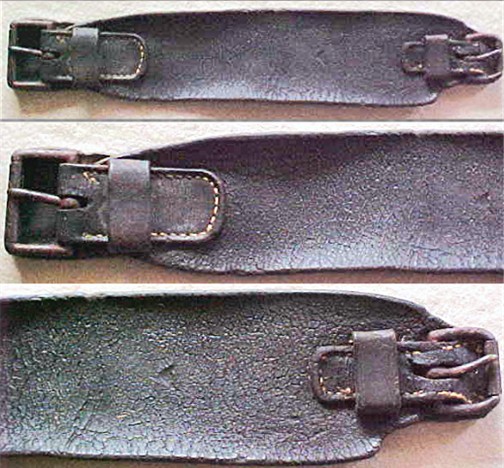
|
|
NO. 3 MODEL 1859 McCLELLAN SADDLE GIRTH
LEATHER VARIANT:
A very good representative
example of the all leather Model 1859 McClellan Saddle
Girth, this girth closely resembles those pictured in
Figure 5, on page 235 of American Military Saddles,
1776-1945.
Like the ones pictured in that reference, this specimen
is formed from a single piece of heavy black leather.
The nearside end still retains the roller buckle, billet
loop and D ring all present and intact. The offside
end has the buckle and billet loop, however the buckle
is missing the tongue that engages the girth strap
billet.
The absence of the buckle tongue
is not particularly noticeable and for the purposes of
display would be only a cosmetic concern. Measuring 22
long and 3 wide, the body of the girth is very pliable
and generally strong with a 1 separation directly below
the nearside buckle and D ring chape. This separation
is limited, not traversing the full width of the girth,
but is mentioned here for an accurate description.
In spite of showing some signs of use and age, this is
still a credible example of a scarce piece of Civil War
Cavalry horse equipment that is missing from most
collections and this girth would certainly complement
your Civil War or early Indian War Cavalry saddle
collection.
SOLD
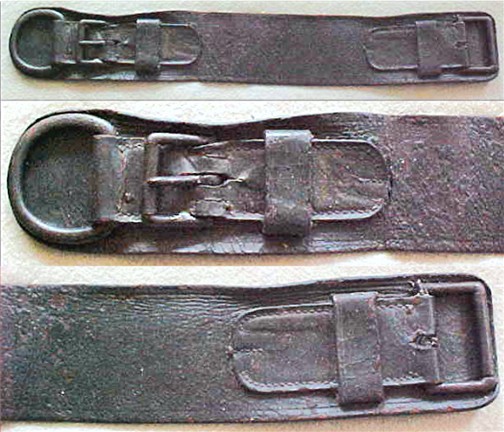 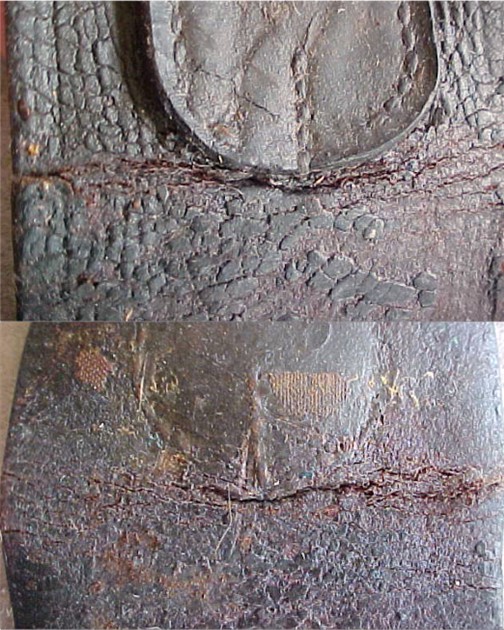
|
|
NO. 4
CIVIL WAR ERA OFFICER'S SADDLE GIRTH:
This is an excellent
example of the all leather girths associated with the
Civil War era Officer's Saddles.
Similar to the ones pictured on page 235 of American
Military Saddles, 1776-1945, this specimen
is formed from a single piece of heavy black leather.
The nearside end is fitted with a large roller buckle
and a billet
loop all present and intact. The offside
end is fitted with a large iron "D" ring. Measuring 26
long and 3
½
wide, the body of the girth is very pliable
and shows very little evidence of use or wear.
This is
a very nice example of a relatively scarce Civil War
Officer's Saddle Girth, one that is difficult to find on
the loose. This girth would certainly complement
your Civil War or early Indian War Cavalry saddle
collection.
SOLD
|
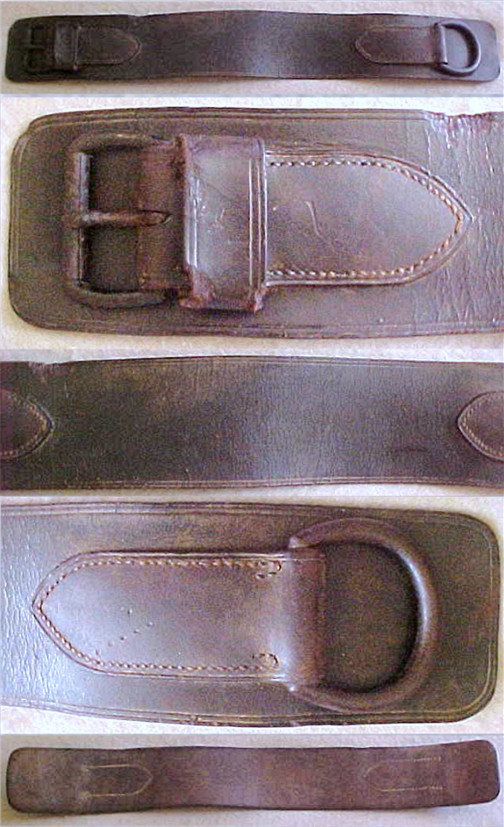 |
|
|
|
|
|
|
|
|
|
|
|
|
|
|
|
|
|
|
|
|
|
|
|
|

